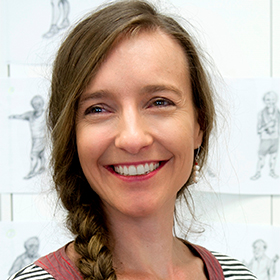A multidisciplinary team of physiotherapists, nurses, cardiologists, psychologists, biomedical engineers, health economists and public health workers has developed an affordable and scalable self-management tool for older people with peripheral arterial disease.
Standing Tall-cardio uses mobile technology to deliver exercise with pain management and behavioural counselling. The program provides individually-tailored tools to help older people suffering from intermittent claudication to lead more active lives, manage their pain and improve health outcomes long-term.
In the 2018 round of UNSW Medicine Neuroscience, Mental Health and Addiction Theme and SPHERE Clinical Academic Group (CAG) Collaborative Research Seed Funding, Associate Professor Kim Delbaere was awarded $40,000 to trial the program in over a six-month period.

Name: Associate Professor Kim Delbaere
Position/s: Principal Research Scientist at Neuroscience Research Australia (NeuRA) and Conjoint Associate Professor at the School of Public Health and Community Medicine, UNSW Sydney
How has the Neuroscience, Mental Health and Addiction Theme and CAG enabled you to develop your research interests?
Intermittent claudication is an intense cramping leg pain triggered by exercise and a common symptom of Peripheral Arterial Disease. Similar to Coronary Arterial Disease, Peripheral Arterial Disease is a narrowing or blockage of arteries - usually due to atherosclerosis and thrombosis – more specifically of arteries in the lower limb. As people age, Peripheral Arterial Disease is more common, with prevalence rates of up to 25% in people over 70 years and up to 40% in people over 80 years. Of all patients with cardiovascular disease, Peripheral Arterial Disease patients have the highest rate of vascular intervention and cardiovascular death. These vascular interventions are very expensive, and while they can be considered a good quick-fix, the symptoms come back if they are not combined with a more active lifestyle. This is what inspired us to look for other solutions. Through the Neuroscience, Mental Health and Addiction Theme and CAG, we were able to bring together a multidisciplinary team of physiotherapists, nurses, cardiologists and psychologists, biomedical engineers, health economists and public health workers with a common interest in healthy and active ageing. Our collaborative thinking led to the development of StandingTall-cardio - an affordable and scalable self-management tool for older people with peripheral arterial disease.
Your project, Standing Tall-cardio. An engaging self-management program and scalable intervention using mobile technology to enhance healthy ageing and reduce fall risk in people with intermittent claudication: a randomised trial, was successful in the 2018 round of Collaborative Research Seed Funding. Can you please tell us about this project?
Research has shown clearly that exercise is as effective as surgery in relieving pain symptoms and the effects last longer. However, the main issue is that exercise in itself is painful for people with intermittent claudication, which explains the low uptake, poor compliance and high dropout rates. StandingTall-cardio was developed using the latest insights in cardiovascular, geriatric and biomedical insights with a strong focus on translation and usability. It uses mobile technology to deliver exercise with pain management and behavioural counselling, all in the comfort of the home. It provides individually-tailored tools to empower older people suffering from intermittent claudication to lead more active lives, manage their pain and thereby improving their health outcomes long-term. This collaborative seed funding will now allow us to test if our self-managed StandingTall-cardio program can increase pain free walking, reduce fall-risk and improve mental wellbeing in 42 people with intermittent claudication over 6-months, compared to a health education program alone.
What impact do you imagine this project will have?
StandingTall-cardio provides an alternative method of participation in physical activity programs by challenging the standard approach. Focus groups and qualitative interviews indicate strong support from patients. One big advantage is that our program can be implemented at low cost with a wide reach in rural and remote areas with limited health care. We are therefore hopeful that, if successful, our self-managed program will change models of patient care for people with intermittent claudication through improved accessibility to evidence-based programs; coaching tools for maintaining exercise goals; and greater levels of support by providing automated feedback to patients through the program and by providing tools for clinicians to remotely monitor compliance and progress of their patients.
How will this project support new collaborations across the Theme and CAG partners?
StandingTall-cardio is the first scalable self-management program for people with Peripheral Arterial Disease delivered through mobile technology. With the global uptake of mobile technology, StandingTall-cardio provides a scalable and affordable m-health solution for cardiovascular disease management and positive ageing – suitable for widespread community application. Our approach may be applied to a wide range of lifestyle-associated conditions currently faced by our ageing population. The collaborative seed funding and project provide an excellent opportunity to bring together leading researchers, clinicians, cardiovascular health stakeholders, end-users and industry partners across multiple organisations with a key interest in healthy ageing. This project may support further collaborations towards facilitating healthy ageing and development of similar self-managed intervention programs.
The Neuroscience, Mental Health and Addiction Theme and CAG consists of four sub-themes and two priority areas:
• Sub-theme: Healthy Ageing
• Sub-theme: Children and Adolescent Wellbeing
• Sub-theme: Complex and Difficult to Treat Diseases
• Sub-theme: Brain Sciences and Translational Neuroscience
• Priority area: Aboriginal Health and Wellbeing
• Priority area: Innovations in Health Technology (Living Lab)


